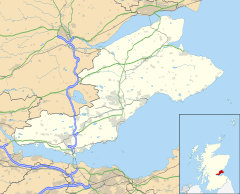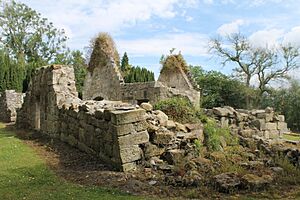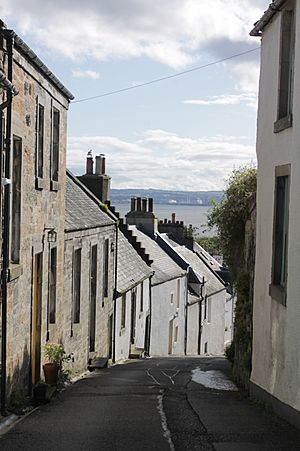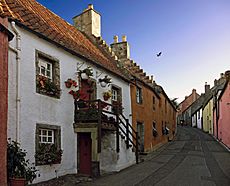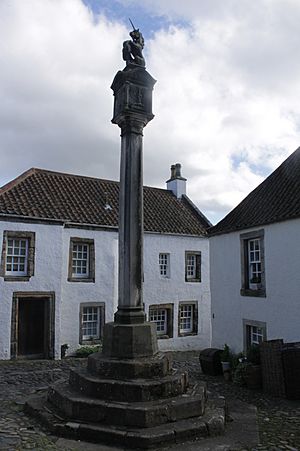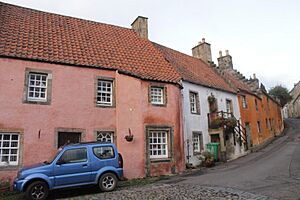Culross facts for kids
Quick facts for kids Culross
|
|
|---|---|
 Culross (including Culross Town House) and the Firth of Forth |
|
| Population | 2,280 (2020 including Valleyfield) |
| Council area | |
| Lieutenancy area | |
| Country | Scotland |
| Sovereign state | United Kingdom |
| Police | Fife |
| Fire | Fife |
| Ambulance | Scottish |
| EU Parliament | Scotland |
| UK Parliament |
|
| Scottish Parliament |
|
Culross is a small village in Fife, Scotland. Its name comes from the Scottish Gaelic words Cuileann Ros, which mean 'holly point'. It used to be a very important royal burgh, which is like a special town with royal rights.
In 2006, about 395 people lived in the village. Culross was once a busy port city on the Firth of Forth. Many people believe that Saint Serf started the village way back in the 500s!
Contents
The Legend of Culross's Beginning
A long time ago, a legend tells us about a princess named Teneu. She was the daughter of the king of Lothian. When she faced a difficult situation, her family threw her from a cliff. But Teneu survived the fall without getting hurt!
Soon after, an empty boat appeared. Teneu knew she had nowhere to go, so she got into the boat. It sailed her across the Firth of Forth until she landed at Culross. Here, Saint Serf took care of her. He became like a foster-father to her son, Saint Kentigern, who was also known as Mungo.
Churches and the Abbey
West Kirk: The Old Church
The very first church in the area, called the "West Kirk," might have been built around the 1000s. It was located a bit to the west of the current village. People stopped using it as a main church around 1500. This meant it wasn't involved in the Scottish Reformation in 1560. However, the West Kirk's churchyard continued to be used for burials for many centuries, even into the 1900s.
Culross Abbey: A Historic Place of Worship
The Cistercian Abbey was built about a mile to the east in 1217. It was dedicated to the Virgin Mary and Saint Serf. Malcolm, Earl of Fife, founded this abbey.
After the Reformation in 1560, a part of the Abbey became the local parish church. It was later restored in 1905. A special chapel for St. Mungo was also built in 1503 by Robert Blackadder, who was the Archbishop of Glasgow. This chapel is now completely gone.
Many ministers served at the Abbey over the centuries. One famous minister in the 1600s was James Fraser of Brea. He was a Covenanter, a group of Scottish Presbyterians who supported their church's independence.
Culross's Industrial Past
In the 1500s and 1600s, Culross was a major center for coal mining. Sir George Bruce of Carnock, who built the famous Culross Palace, started a coal mine here in 1575.
The Moat Pit: An Underwater Mine
In 1590, Sir George Bruce created something amazing: the Moat Pit at Culross. This was the first coal mine in the world to go under the sea! Miners worked on a coal seam known as the Upper Hirst. They had clever ways to drain the water that constantly leaked in from above.
This mine was considered a true marvel in the early 1600s. A visitor named John Taylor called it "a wonder... an unfellowed and unmatchable work." Sadly, the Moat Pit was destroyed in a big storm on March 30, 1625.
Salt Production and Trade
Another important industry in Culross was salt panning. This is where salt is made by evaporating seawater. In 1573, there were seven salt pans in Culross. The owners were allowed to export salt, but they had to pay a tax to the Scottish royal mint. However, in 1574, the export of salt was stopped for a while because there wasn't enough salt in Scotland.
Culross had a busy sea trade, exporting coal and salt. You might notice many red roof tiles in Culross and other Fife villages. This is thought to be because coal ships would return to Culross carrying Dutch roof tiles as ballast (heavy material to keep the ship stable). The town was also known for making girdles, which are flat iron plates used for baking over a fire.
Decline of the Port
From the 1700s, Culross's role as a port began to decline. By the Victorian era, it had become much quieter. The harbor was eventually filled in, and a coastal railway line cut off access to the sea in the early 1900s. Recently, the outer pier has been repaired.
Culross's Rich Heritage

Culross has many amazing historic buildings. These include the Culross Town House, which used to be a courthouse and prison. There's also the 1500s Culross Palace and the 1600s Culross Study. You can also see the remains of the Culross Abbey, founded in 1217. The tower, transepts, and choir of the Abbey Church are still used as the parish church today. The ruined parts of the Abbey are looked after by Historic Environment Scotland.
The old West Kirk stopped being used as the main church before 1633. It was also a place where four women, accused of witchcraft, were said to have met before their execution in 1675.
Just outside the town is Dunimarle Castle, built in the 1700s by the Clan Erskine family. It replaced an older medieval castle.
Thomas Cochrane, 10th Earl of Dundonald, a famous naval officer, spent much of his early life in Culross. His family owned an estate here. A statue of him can be seen outside the Town House. He was the first Vice Admiral of Chile.
In the 1900s, people realized how special Culross's historical buildings were. Since the 1930s, the National Trust for Scotland has been working hard to protect and restore them.
Culross on Screen
Culross has been a popular spot for filming movies and TV shows! Some films shot here include Kidnapped (1971), The Little Vampire (2000), and Captain America: The First Avenger (2011). In 2013, the popular TV series Outlander also began filming in Culross.
Famous People from Culross
Many notable people have connections to Culross:
- George Bruce of Carnock (1550–1625), a powerful lord who built Culross Palace.
- Christian Cavendish, Countess of Devonshire (1595–1675), who owned Culross Abbey House.
- Thomas Cochrane, 10th Earl of Dundonald (1775–1860), a brave naval officer and politician.
- Elizabeth Melville (c.1578–c.1640), known as "Lady Culross," was Scotland's first published female poet.
- Stewart McPherson (VC) (1822–1892), who received the Victoria Cross for his bravery.
- Jackie Sinclair (1943–2010), a Scottish international footballer.
Twin Town
Culross is twinned with the Dutch town of Veere. Veere used to be the main port where goods from Culross were sent to the Low Countries.


